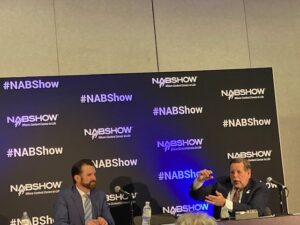
After more than 40 years of operation, DTVE is closing its doors and our website will no longer be updated daily. Thank you for all of your support.
NAB Show 2023: Sinclair says it will deliver core network for data delivery via broadcast

Chris Ripley and Mark Aitken
US broadcast group Sinclair used a press event at the NAB Show Saturday to talk up its commitment to deliver a data distribution core network, which the company pitched as an open network designed to enable broadcasters and other providers of services to deliver data more efficiently using the broadcast network to supplement other network infrastructure such as 5G.
Sinclair president and CEO Chris Ripley said that the industry was at “an inflection point”. He said that the US ATSC 3.0/Next Gen TV standard, which is currently deployed to about 60% of the US, had enabled broadcasters to take a seat at the distribution table.
He said that Sinclair would build “an interconnected broadcast platform” with datacasting that would deliver IP-delivered content across the country. The platform will be ready for deployment in Q1 of next year.
The platform would match capacity with the needs of data distributors, he said. Datacasting would be competitive with other data distribution mechanisms while preserving the business of broadcasters, he said.
Ripley said the one-to-many capability of its core network would enable a wide range of services. Data distribution to cars would enable software upgrades and infotainment applications using the datacast network, he said, adding that the platform would enable emergency alerts to be delivered more efficiently, while preserving the broadcast path for critical emergency information.
“This is the only scalable solutions that exists today,” said Ripley.
He said that “data distribution as a service is the inevitable step forward” for broadcast.
Mark Aitken, SVP of Advanced Technology, said that the existing ATSC core network was critical in taking datacasting forward. The core network was “an educational exercise” which had also led to many relationships being developed that allowed Sinclair to develop its own network.
Aitken said that this was “an ancillary business” for broadcast rather than a replacement for broadcast TV.
He highlighted automotive as a key target market for the datacasting network’s one-to-many capabilities.
“The ability to do one-to-many as opposed to the unicast capability of 5G or 4G is a massive energy saver,” he said.
“This is an extension – it’s a platform of platforms. It’s about the most appropriate platform for the distribution of data. It might be about offloading…during live events,” said Aitken.

